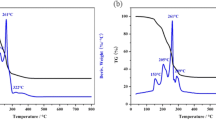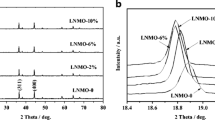Abstract
LiAl x Mn2 − x O4 and LiAl0.05Mn1.95O4 − y F y spinel have been successfully synthesized by citric acid-assisted sol–gel method. The structure and physicochemical properties of this as-prepared powder were investigated by electronic conductivity test, powder X-ray diffraction (XRD), scanning electron microscopy (SEM), electrochemical impedance spectroscopy (EIS), and galvanostatic charge–discharge test in detail. The electronic conductivity decreases with increasing of the content of doped Al. XRD patterns show that the diffraction of LiAl0.05Mn1.95O4 − y F y samples is similar, with all the peaks indexable in the Fd3m space group, and a little impurity appears in the LiAl0.05Mn1.95O3.8F0.2 sample. SEM reveals that all LiAl0.05Mn1.95O4 − y F y powders have the uniform, nearly cubic structure morphology with narrow size distribution which is less than 500 nm. Galvanostatic charge–discharge test indicates that LiAl0.05Mn1.95O4 has the highest discharge capacity and electrochemical performance among all LiAl x Mn2 − x O4 samples after 50 cycles, and the initial discharge capacity of LiAl0.05Mn1.95O4 − y F y (y = 0, 0.02, 0.05, 0.1) is 123.9, 124.6, 124.9, and 125.0 mAh g−1, respectively, and their capacity retention ratios are 94.2%, 94.9%, 91.7%, and 89.9% after 50 cycles, respectively. EIS indicates that LiAl0.05Mn1.95O3.98F0.02 have smaller charge transfer resistance than that of LiAl0.05Mn1.95O4 corresponding to the extraction of Li+ ions.






Similar content being viewed by others
References
Shin HC, Cho WI, Jang H (2006) Electrochim Acta 52:1472
Chung SY, Bloking JT, Chiang YM (2002) Nat Mater 1:123
Thackeray MM, Johnson PJ, Picciotto de LA, Bruce PG, Goodenough JB (1984) Mater Res Bull 19:179
Yi TF, Hu XG, Gao K (2006) J Power Sources 162:636
Wang H-C, Lu CH (2003) J Power Sources 119–121:738
Liu RS, Shen CH (2003) Solid State Ionics 157:95
Yi T-F, Zhu Y-R (2008) Electrochim Acta 53:3120
Kakuda T, Uematsu K, Toda K, Sato M (2007) J Power Sources 167:499
Lee YS, Kumada N, Yoshio M (2001) J Power Sources 96:376
Bao S-J, Liang Y-Y, Zhou W-J, He B-L, Li H-L (2005) J Colloid Interf Sci 291:433
Yi TF, Dai CS, Gao K, Hu XG (2006) J Alloys Compds 425:343
Shao-Horn Y, Middaugh RL (2001) Solid State Ionics 139:13
Yi TF, Hu XG, Huo HB, Gao K (2006) Rare Metal Mat Eng 35:1350
Doron A, Yair E-E, Chusid O, Carmeli Y, Babai M, Yamin H (1994) J Electrochem Soc 141:603
Chusid O, Eli YE, Aurbach D, Babai M, Carmeli, Y (1993) J Power Sources 43:47
Hunter JC (1981) J Solid State Chem 39:142
Tarascon JM, Mckinnon WR, Coowar F, Bowmer TN, Amatucci G, Guyomard D (1994) J Electrochem Soc 141:1421
Yi TF, Hu XG, Dai CS, Gao K (2007) J Mater Sci 423:825
Kim G-H, Kim J-H, Yoon CS, Myung S-T, Sun Y-K (2005) J Electrochem Soc 152:1707
Levi MD, Aurbach D (1997) J Phys Chem B 101:4630
Levi MD, Levi EA, Aurbach D (1997) J Electroanal Chem 421:89
Zhang SS, Xu K, Jow TR (2004) Electrochim Acta 49:1057
Shu D, Chung KY, Cho WI, Kim K-B (2003) J Power Sources 114:253
Wu X, Zong X, Yang Q, Jin Z, Wu H (2001) J Fluorine Chem 107:39
Balasubramanian M, Lee HS, Sun X, Yang XQ, Moodenbaugh AR, Mcbreen J, Fischer DA, Fu Z (2002) Electrochem Solid-State Lett 5:A22
Acknowledgments
This work was performed by the financial support of Student Research & Training Program (SRTP, no. 08019) of Anhui University of Technology. The authors thank Prof. Xinguo Hu of Harbin Institute of Technology and Dr. Ying Wang of Institute of Chemistry Chinese Academy of Sciences for their helpful discussion on the experimental techniques.
Author information
Authors and Affiliations
Corresponding author
Rights and permissions
About this article
Cite this article
Yi, TF., Zhu, YR., Zhu, RS. et al. Physicochemical properties of LiAl x Mn2 − x O4 and LiAl0.05Mn1.95O4 − y F y cathode material by the citric acid-assisted sol–gel method. Ionics 15, 177–182 (2009). https://doi.org/10.1007/s11581-008-0248-6
Received:
Revised:
Accepted:
Published:
Issue Date:
DOI: https://doi.org/10.1007/s11581-008-0248-6




